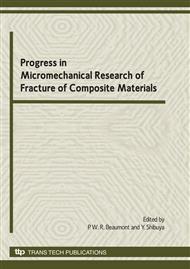p.19
p.31
p.41
p.47
p.53
p.69
p.83
p.101
p.115
Stress-Corrosion Cracking in Unidirectional GFRP Composites
Abstract:
A micromechanical theory of macroscopic stress-corrosion cracking in unidirectional glass fiber-reinforced polymer composites is proposed. It is based on the premise that under tensile loading, the time-dependent failure of the composites is controlled by the initiation and growth of a crack from a pre-existing inherent surface flaw in a glass fiber. A physical model is constructed and an equation is derived for the macroscopic crack growth rate as a function of the apparent crack tip stress intensity factor for mode I. Emphasis is placed on the significance of the size of inherent surface flaw and the existence of matrix crack bridging in the crack wake. There exists a threshold value of the stress intensity factor below which matrix cracking does not occur. For the limiting case, where the glass fiber is free of inherent surface flaws and matrix crack bridging is negligible, the relationship between the macroscopic crack growth rate and the apparent crack tip stress intensity factor is given by a simple power law to the power of two.
Info:
Periodical:
Pages:
101-113
Citation:
Online since:
March 2010
Authors:
Price:
Сopyright:
© 2010 Trans Tech Publications Ltd. All Rights Reserved
Share:
Citation:


